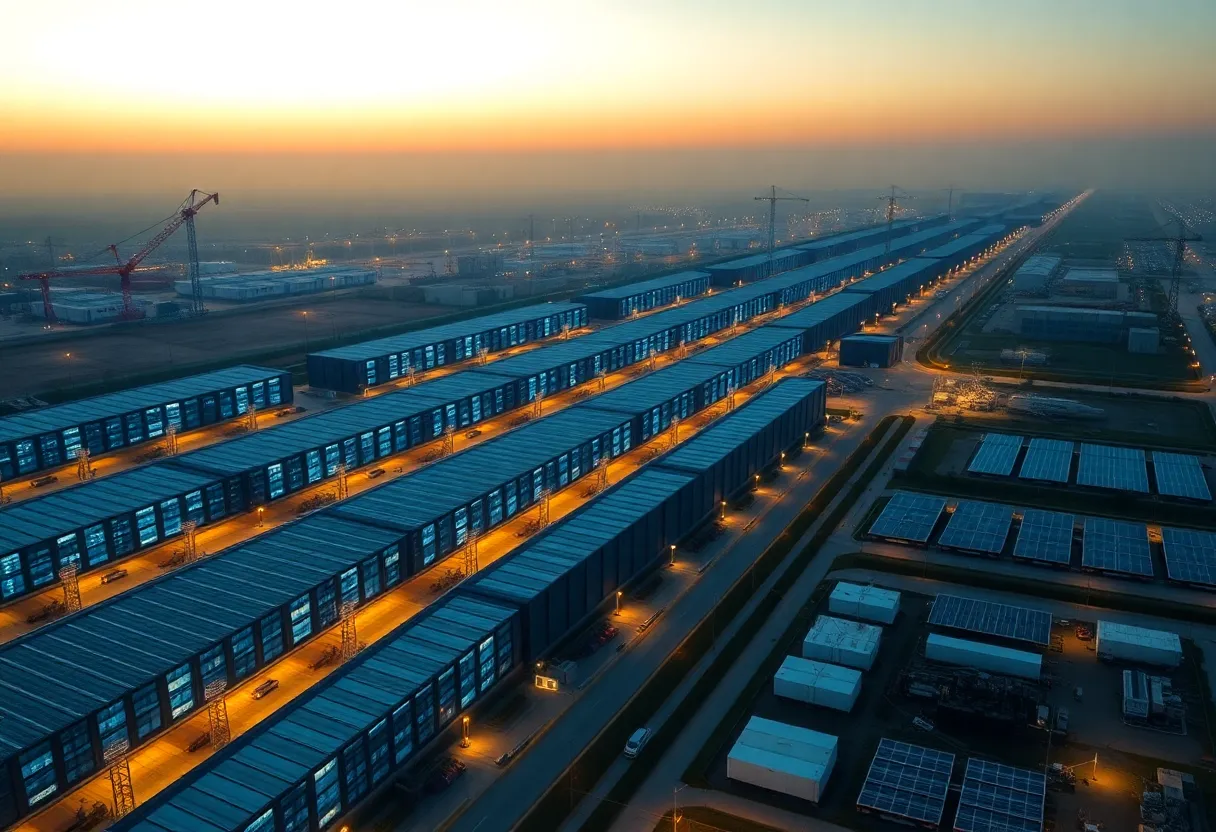, September 27, 2025
News Summary
Rapid hyperscale cloud and AI growth is triggering a capital‑intensive sprint to build next‑generation data centers, requiring project‑level construction debt, HoldCo facilities, mezzanine equity and permanent takeouts. Developers and lenders are adopting layered financing and accelerated diligencing to close larger, higher‑power projects, while local grids and communities confront transmission upgrades, backup generator pollution and debates over who pays. Key hubs from northern Virginia to I‑85 corridors and parts of Texas face rising rents and multi‑gigawatt demand forecasts. Early financial planning, comprehensive documentation and utility coordination are now essential to reduce execution risk and secure lower long‑term costs.
Hyperscaler push for AI and cloud drives a capital‑heavy data center boom, new finance tools and grid fights
The race among the largest cloud and AI providers is pushing developers into a capital‑intensive push to build modern data centers. At the top of the story are three linked trends: a need for massive, single‑tenant campuses tailored to hyperscalers; rapid innovation in how those projects are financed; and mounting pressure on regional power grids and local policy makers.
Why this matters now
Demand for AI services and cloud capacity is forcing IT planners to look years ahead, and hyperscalers are committing to projects that can require enormous power and cash up front. Modern campuses can need more than 1 gigawatt of power and often cost billions of dollars to construct. That scale changes the financing playbook and turns the grid into a core battleground for tech expansion.
How developers are financing the buildout
The base building block of most deals is project‑level construction debt. These loans cover the hard and soft costs of building a data center, and they generally run three to five years through the start of operations. Unlike typical commercial real estate lending, these financings are underwritten not just on land value but also on a broader set of project‑specific factors tied to the tenant, technology and grid connections.
To match hyperscaler timetables and risk profiles, developers are layering new structures on top of traditional construction loans. Larger owners often use holding‑company (HoldCo) financing to manage portfolio risk and provide flexibility when individual projects face delays or cost overruns. These HoldCo facilities sit up the borrower chain and are structured to give developers runway without tying up each project directly.
At the other end of the cycle, once a data center is stabilized and producing predictable lease cash flows, construction debt is typically replaced by permanent (takeout) financing. Common takeout forms include syndicated term loans, private placements and asset‑backed securitizations. These permanent products usually deliver higher advance rates and lower borrowing costs because construction risk has been removed and tenant credit profiles are clear.
Diligence, documentation and timing matter
Lenders expect developers to come prepared. Typical conditions include copies of material project contracts such as the lease, a construction contract with a guaranteed maximum price, and third‑party diligence reports — appraisals, technical consultant reports, and environmental site assessments. Successfully moving from land purchase to initial funding quickly has become a strategic advantage as lender and contractor appetite tightens and competition for labor and materials grows.
Grid strain and public pushback
Rapid campus growth has put huge stress on regional grids. In some service territories, peak demand forecasts show multi‑gigawatt increases over the next decade. One region projects peak data center demand could rise to about 13.3 gigawatts by 2038, nearly five times a recent baseline. Large projects can draw more than 100 megawatts — roughly the power demand of tens of thousands of homes — and many installations keep diesel generators on site for backup, adding another layer of community and environmental concern.
Utilities are responding with major transmission and substation investments, often funded through broad customer cost‑recovery mechanisms. That has triggered a public policy debate over who ultimately pays for upgrades: residential ratepayers, data center operators, or a mix of both. Some jurisdictions have launched studies and legislative processes to reassess rate classes and cost allocation as local officials try to balance economic development with neighborhood impacts.
Where capacity is growing and the market response
Several U.S. corridors are emerging as hotspots. Longstanding hubs with abundant fiber and power remain attractive, while new regions are gaining ground because of open land, renewable energy and tax incentives. Rent levels for wholesale data center space have increased in key markets, complicating planning for enterprises that split workloads between public cloud and on‑premises facilities.
Market participants — developers, lenders, technical consultants and title firms — are growing more sophisticated. Headline‑scale transactions are more common, and capital markets for data center assets have expanded rapidly. But the lines between project finance, real estate finance and leveraged finance are blurring, requiring tailored strategies for each stage of an asset’s life cycle.
What developers and corporate IT teams should do
- Plan financing early and align construction debt, HoldCo options and takeout strategies to the project timeline.
- Engage finance, tax, legal and technical teams before closing land deals so diligence can proceed quickly.
- Anticipate grid timelines and factor transmission and generation lead times into schedules; there are no quick fixes when capacity is unavailable.
- Prepare a clear development narrative for lenders that addresses contract certainty, environmental diligence and power procurement.
Bottom line
Growth in AI and cloud is driving a construction boom that is capital‑intensive, power hungry and politically charged. Developers who combine speedy execution, sophisticated financing mixes and early engagement with technical and legal advisers will be better positioned to win deals and control costs. Policymakers and utilities face difficult choices about how to fund and pace grid upgrades as data center demand keeps rising.
Note: This article is informational and general in nature and does not constitute legal or financial advice. Specific project decisions should be made after consultation with qualified advisors.
Frequently Asked Questions
What is a hyperscaler data center?
A hyperscaler data center is a large, often single‑tenant campus built for major cloud and AI providers. These facilities are designed for high compute density, large power loads, extensive cooling and direct connectivity to fiber networks.
How is construction financing for these projects different?
Lenders underwrite these loans on more than just real estate value. They consider tenant credit, technical readiness, power interconnection risk and construction contracts. Loan terms usually cover the construction period and the initial months of operation.
What is HoldCo financing and why use it?
HoldCo financing is arranged at the parent company level rather than against a single project. It gives developers flexibility to support multiple projects, handle delays or cost overruns, and manage portfolio risk.
How big are the power needs for these campuses?
Modern campuses can exceed 1 gigawatt of demand, and regional peaks attributable to data centers can reach multiple gigawatts. That scale requires new transmission lines, substations and sometimes new generation sources.
What should developers prepare for lenders?
Typical lender requirements include the signed lease, a construction contract with a guaranteed maximum price, appraisals, technical consultant reports, environmental assessments and a coherent plan for grid connections and permits.
Are there broader community impacts?
Yes. Heavy power use, backup generators, and large construction projects can affect local rates, air and noise conditions, and land use. Communities often debate who should pay for grid upgrades to support data center growth.
{
“@context”: “https://schema.org”,
“@type”: “FAQPage”,
“mainEntity”: [
{
“@type”: “Question”,
“name”: “What is a hyperscaler data center?”,
“acceptedAnswer”: {
“@type”: “Answer”,
“text”: “A hyperscaler data center is a large, often single‑tenant campus built for major cloud and AI providers, designed for high compute density, large power loads, extensive cooling and direct connectivity to fiber networks.”
}
},
{
“@type”: “Question”,
“name”: “How is construction financing for these projects different?”,
“acceptedAnswer”: {
“@type”: “Answer”,
“text”: “Lenders underwrite these loans on more than just real estate value, considering tenant credit, technical readiness, power interconnection risk and construction contracts. Loan terms usually cover the construction period and the initial months of operation.”
}
},
{
“@type”: “Question”,
“name”: “What is HoldCo financing and why use it?”,
“acceptedAnswer”: {
“@type”: “Answer”,
“text”: “HoldCo financing is arranged at the parent company level rather than against a single project. It provides flexibility to support multiple projects, handle delays or cost overruns, and manage portfolio risk.”
}
},
{
“@type”: “Question”,
“name”: “How big are the power needs for these campuses?”,
“acceptedAnswer”: {
“@type”: “Answer”,
“text”: “Modern campuses can exceed 1 gigawatt of demand, and regional peaks attributable to data centers can reach multiple gigawatts, requiring new transmission lines, substations and sometimes new generation sources.”
}
},
{
“@type”: “Question”,
“name”: “What should developers prepare for lenders?”,
“acceptedAnswer”: {
“@type”: “Answer”,
“text”: “Typical lender requirements include the signed lease, a construction contract with a guaranteed maximum price, appraisals, technical consultant reports, environmental assessments and a plan for grid connections and permits.”
}
},
{
“@type”: “Question”,
“name”: “Are there broader community impacts?”,
“acceptedAnswer”: {
“@type”: “Answer”,
“text”: “Yes. Heavy power use, backup generators, and large construction projects can affect local rates, air and noise conditions, and land use. Communities often debate who should pay for grid upgrades to support data center growth.”
}
}
]
}
Key features at a glance
| Feature | What it means | Typical numbers / examples |
|---|---|---|
| Project‑level construction debt | Loan that funds construction and early operations of a single data center or campus | Term: 3–5 years; covers hard and soft costs; replaces at stabilization |
| HoldCo financing | Parent‑level facility that backs multiple projects and offers flexibility | Used to manage cost overruns and portfolio risk; often structured with special lender protections |
| Permanent takeout capital | Long‑term financing that replaces construction debt once cash flows stabilize | Includes syndicated loans, private placements, ABS; typically lower cost than construction loans |
| Power demand | Major constraint for siting and timing; drives transmission and generation projects | Single campus: >1 GW possible; regional peaks could reach double‑digit GW over decades |
| Developer readiness | Speed matters for closing land, permits and financing | Prepared packages include lease, GMP contract, appraisal, tech and environmental reports |
Deeper Dive: News & Info About This Topic
Additional Resources
- CIO Dive: Hyperscaler cloud and AI data capacity strains
- Wikipedia: Data center
- Virginia Mercury: Loudoun County neighbors fight proposed Dominion transmission lines
- Google Search: Loudoun County data centers transmission lines
- NBC Washington: Residents fight Dominion transmission line project in Ashburn
- Encyclopedia Britannica: Electric power transmission
- Bloomberg: Loudoun County data center growth strains residents seeking AI regulation
- Google News: Loudoun County data centers AI regulation
- Construction Dive: Executive order aims to speed data center construction
- Google Scholar: data center construction permitting
Author: Construction CA News
The CALIFORNIA STAFF WRITER represents the experienced team at constructioncanews.com, your go-to source for actionable local news and information in California and beyond. Specializing in "news you can use," we cover essential topics like product reviews for personal and business needs, local business directories, politics, real estate trends, neighborhood insights, and state news affecting the area—with deep expertise drawn from years of dedicated reporting and strong community input, including local press releases and business updates. We deliver top reporting on high-value events such as the Rose Parade, Coachella, Comic-Con, and the California State Fair. Our coverage extends to key organizations like the California Building Industry Association and Associated General Contractors of California, plus leading businesses in technology and entertainment that power the local economy such as Apple and Alphabet. As part of the broader network, including constructionnynews.com, constructiontxnews.com, and constructionflnews.com, we provide comprehensive, credible insights into the dynamic landscape across multiple states.




